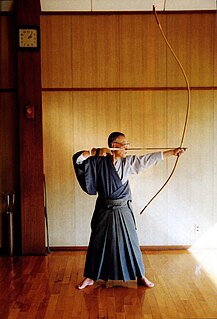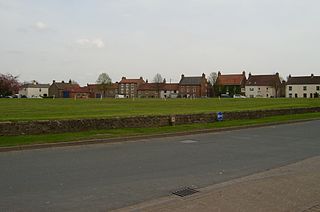Related Research Articles

Archery is the art, sport, practice, or skill of using a bow to shoot arrows. The word comes from the Latin arcus for bow. Historically, archery has been used for hunting and combat. In modern times, it is mainly a competitive sport and recreational activity. A person who participates in archery is typically called an archer or a bowman, and a person who is fond of or an expert at archery is sometimes called a toxophilite or a marksman.

Kyūdō (弓道) is the Japanese martial art of archery. Experts in kyūdō are referred to as kyūdōka (弓道家). Kyūdō is based on kyūjutsu, which originated with the samurai class of feudal Japan. Kyūdō is practised by thousands of people worldwide. As of 2005, the International Kyudo Federation had 132,760 graded members.

The bow and arrow is a ranged weapon system consisting of an elastic launching device (bow) and long-shafted projectiles (arrows).
There were four different Archery competitions at the 1992 Summer Olympics. The format of the previous Olympics was dropped for this Olympiad, with an entirely new system being put in place.

Archery at the 2004 Summer Olympics was held at Panathinaiko Stadium in Athens, Greece with ranking rounds on 12 August and regular competition held from 15 August to 21 August. One hundred twenty-eight archers from forty-three nations competed in the four gold medal events—individual and team events for men and for women—that were contested at these games.

Archery had its debut at the 1900 Summer Olympics and has been contested in 16 Olympiads. Eighty-four nations have competed in the Olympic archery events, with France appearing the most often at 31 times. The most noticeable trend has been the excellence of South Korean archers, who have won 23 out of 34 gold medals in events since 1984. It is governed by the World Archery Federation. Recurve archery is the only discipline of archery featured at the Olympic Games. Archery is also an event at the Summer Paralympics.

The Royal Company of Archers is a ceremonial unit that serves as the Sovereign's Bodyguard in Scotland, a role it has performed since 1822 during the reign of King George IV, when the company provided a personal bodyguard to the King on his visit to Scotland. It is currently known as the Queen's Bodyguard For Scotland, and is located in Edinburgh, the capital city. The Royal Company of Archers has a long history in Scotland as a body that celebrated both the recreation and talent of local archers. As a body established by the Monarch, the Company has a long history of unique prizes, influential supporters, and ceremonial roles.
The Antient Scorton Silver Arrow is an archery tournament that was incepted on Sunday 14 May 1673 in the village of Scorton in Yorkshire, England. Twenty-two archers competed in the first event for the prize of a silver arrow. This was won by Henry Calverley of Eryholme on Tees, who had provided the trophy. The event proved so successful that a new organisation, the Society of Archers, was formed to hold the event on an annual basis.

Scorton is a village and civil parish in the Richmondshire district of North Yorkshire, England. It is approximately 8 miles (13 km) north-west of the county town of Northallerton.
Scorton Feast is an annual event held at Scorton, North Yorkshire, England. Many activities are held on the raised village green, although there are currently several other key sites including Beck Green and the Archery field, the Gymkhana/Harness Racing field off Banks Lane, and the Flower Show tent on Bolton Road.

Archery, or the use of bow and arrows, was developed by the end of the Upper Paleolithic. Archery has been an important military and hunting skill for over 10,000 years and figures prominently in the mythologies of many cultures. Archers, whether on foot, in chariots or mounted on horses were a major part of most military forces until they began being gradually supplemented, then replaced, by firearms in the Late Middle Ages and in the early modern period. Gunpowder, which was first developed in China in the 9th century AD, was initially used to enhance projectile weapons including arrows. Firearms diffused throughout Eurasia by the gunpowder empires, gradually reducing the importance of archery in warfare.

Target archery is the most popular form of archery, in which members shoot at stationary circular targets at varying distances. All types of bow – longbow, barebow, recurve and compound – can be used. In Great Britain, imperial rounds, measured in yards, are still used for many tournaments and these have slightly different rules to metric (WA) rounds, which are used internationally. Archers are divided into seniors and juniors, with juniors being those under the age of 18.

The women's individual at the 2004 Summer Olympics as part of the archery programme were held at the Panathinaiko Stadium.

Popinjay or Papingo, also called pole archery, is a shooting sport that can be performed with either rifles or archery equipment. The object of popinjay is to knock artificial birds off their perches. The rifle form is a popular diversion in Denmark; a Scottish variant is also known. The archery form, called staande wip in Flemish language, is popular in Belgium and is shot occasionally in the United Kingdom under the governance of the Grand National Archery Society. In Germany a traditional shooting at wooden birds placed on a high pole is called "Vogelschießen". These are carried out either with small bore rifles or crossbows.

Clout archery is a form of archery in which archers shoot arrows at a flag from a relatively long distance and score points depending on how close each arrow lands to the flag.

The men's individual archery event at the 2008 Summer Olympics was part of the archery programme and took place at the Olympic Green Archery Field. Ranking Round was scheduled for 9 August. First and second elimination rounds took place on 13 August, and eights, quarterfinal, semifinals and medals matches were staged on 15 August. All archery was done at a range of 70 metres, with targets 1.22 metres in diameter.

The men's team archery event at the 2008 Summer Olympics was part of the archery programme and took place at the Olympic Green Archery Field. Ranking Round was scheduled for August 9 and elimination rounds and Finals took place on August 11. All archery is done at a range of 70 metres, with targets 1.22 metres in diameter.

The girls' individual archery event at the 2010 Summer Youth Olympics was held from 18 to 20 August 2010 at the Kallang Field in Kallang, Singapore. It was one of three recurve archery events which comprised the archery programme at the inaugural Summer Youth Olympics, and featured thirty-one archers from thirty-one countries. Entry was open to female archers born between 1 January 1992 and 31 December 1993.
Modern competitive archery involves shooting arrows at a target for accuracy and precision from a set distance or distances. This is the most popular form of competitive archery worldwide and is called target archery. A form particularly popular in Europe and America is field archery, shot at targets generally set at various distances in a wooded setting. There are also several other lesser-known and historical forms, as well as archery novelty games.

The girls' individual archery event at the 2018 Summer Youth Olympics was held from 12 to 16 October 2018 at the Parque Sarmiento in Buenos Aires, Argentina. One of three recurve archery events which comprised the archery programme, it was the third time the girls' individual discipline had been contested at Summer Youth Olympics. Thirty-two archers from thirty-two countries entered the competition, which was open to female archers born between 1 January 2001 and 31 December 2003. The defending champion was China's Li Jiaman, who was unable to defend her title due to the age limitations imposed on the event.
References
| This archery article is a stub. You can help Wikipedia by expanding it. |